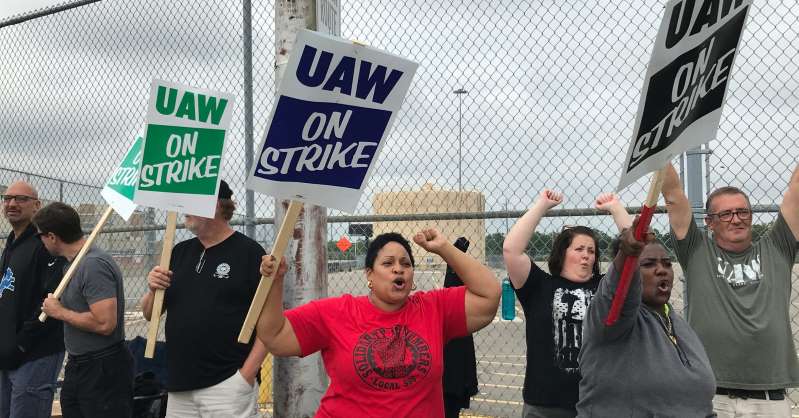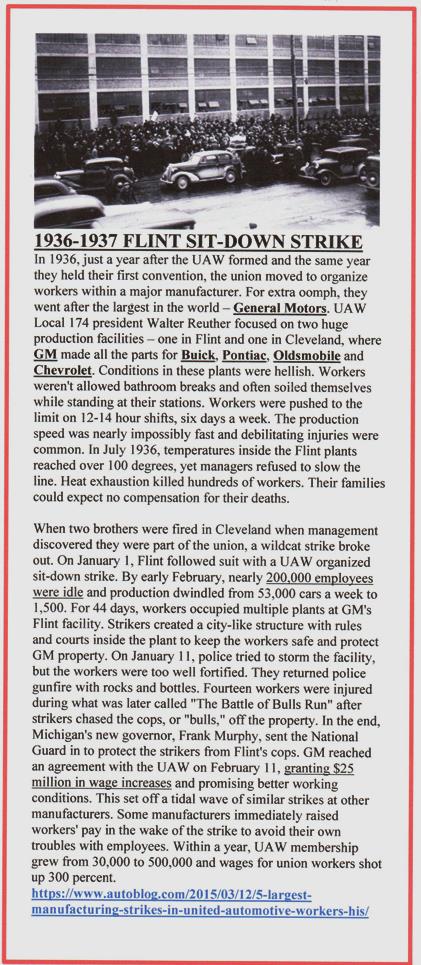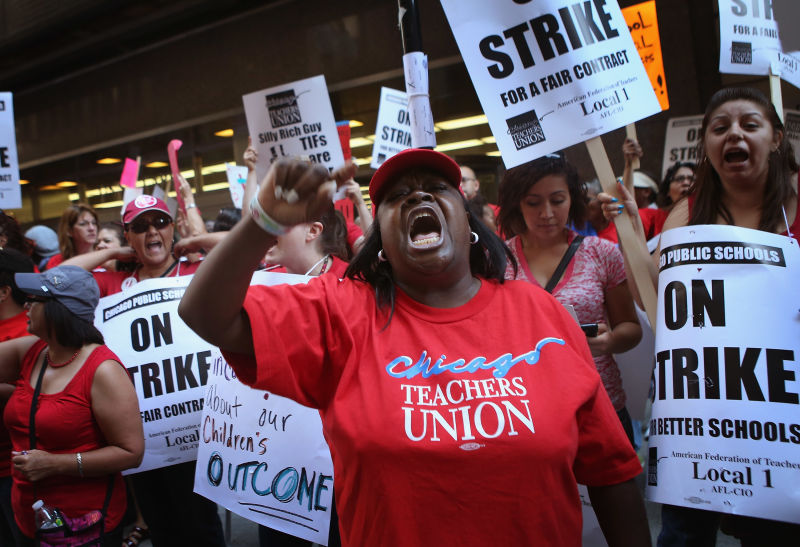
UAW members on strike outside Flint GM plant Sept. 16, 2019. CNBC photo
It could be tough on those who have walked off the job and away from a regular paycheck. But it could be great for the country.
Largest labor action in U.S. in over 10 years
Inspired by service workers’ strikes: teachers, janitors, fast food workers
By Sarah Lahm
The Progressive
September 16, 2019
 Close to 50,000 United Auto Workers across the United States are on strike against General Motors as of 11:59 p.m., September 15. If the strike goes on for any real length of time, it’ll be tough on those who have walked off the job and away from a regular paycheck.
Close to 50,000 United Auto Workers across the United States are on strike against General Motors as of 11:59 p.m., September 15. If the strike goes on for any real length of time, it’ll be tough on those who have walked off the job and away from a regular paycheck.
But it could be great for the country.
The UAW strike is the largest labor action in the United States in at least a decade, and the first for the union in twelve years. Images are cropping up of auto workers walking the picket line, carrying boldly lettered “On Strike” signs and chanting their rallying cries: “What do we want? Jobs! What do we need? Security!”
The UAW strike is the largest labor action in the United States in at least a decade, and the first for the union in twelve years.
It’s a worker-led contrast to the choreographed, kabuki theater scenes of the 2020 election season, including the most recent Democratic debates. It does matter, of course, who becomes President in 2020. But whoever wins the highly orchestrated, carefully managed match-up between Trump (his party’s likely nominee despite the presence of a few rivals) and the Democratic candidate will still be just one person—even if that person is a skilled purveyor of populist ideals and plans, such as Bernie Sanders or Elizabeth Warren.
And even if a Democrat does win the presidential election, he or she will most likely face a recalcitrant Republican majority in the Senate. Or, as Mark Barabak put it in a recent opinion piece for the Los Angeles Times, zero percent of the “fine-sounding pledges,” such as free college and affordable health care, are likely to “come to pass, however, if Democrats can’t also win control of the Senate in November 2020.”
But the UAW strikers are many, and include more than just relatively well-paid auto workers—some of whom can command wages and benefits that top $70 per hour. The first autoworkers who walked off the job are employed at the General Motors plant in Flint, Michigan. As they headed to work for their final, pre-strike shift on September 15, the autoworkers passed a group of janitors who are also UAW members that work in the Flint auto plant—who were already on strike
According to the Detroit Free Press, the janitor strike prompted the autoworkers—who were still waiting for the strike authorization nod from union leaders—to stop by the janitors’ picket line offering food, a well-directed curse word or two, and a desire to band together in solidarity.
About 850 janitors at GM plants in Ohio and Michigan work for contractor Aramark but are represented by the UAW. In a video posted to the Detroit Free Press website, Damon “D.J.” Harrison describes the treacherous work he and his fellow maintenance workers perform at the General Motors plant in exchange for an hourly wage that hovers around $15.
“We do these water blasts,” Harrison said, noting that the high powered sprayers they use are strong enough to slice off a “foot or finger.”
For Harrison and his fellow janitors, access to affordable health care isn’t a nice talking point to lob at an opponent on a debate stage—it’s a matter of life and death. “We have families to live for,” Harrison told the Detroit Free Press, before shaking his head and appearing to walk off camera.
He hit the picket line in part to rally for manageable health care costs. This puts him in solidarity with the UAW plant workers who walked off the job just hours after the janitors did. They are also pushing back against the climbing cost of health care, even as General Motors continues to score billions in annual profits.
These are the stories of rank-and-file workers who possess, perhaps, the numbers and the drive to shift the imbalance of the massive inequality that dominates life in the United States today.
These are the stories of rank-and-file workers who possess, perhaps, the numbers and the drive to shift the imbalance of the massive inequality that dominates life in the United States today. While the UAW strike is the largest the country has seen in years, it is taking place alongside other noteworthy labor actions led by working people.

Chicago teachers’ strike 2012.
Look no further than Chicago. In 2012, the city’s teachers mounted a strike seen by many as an impressive show of union strength in an era of declining rights for workers. Now, the 35,000-member Chicago Teachers Union is poised to go on strike again; this time, thousands of school-based staffers represented by the Service Employees International Union may join them.
In an article in Jacobin, Alan Maass detailed the brewing Chicago battle, noting that the special education assistants, bus drivers, and other workers represented by the Service Employees International Union make so little money that they fall into the federal government’s “very low income” range. The collective union members in Chicago are also reportedly ready to push back against privatization, an ongoing transfer of wealth from publicly funded, publicly managed entities into private hands.
The stories of these workers, backed by work stoppages and strike votes, are worth paying attention to, and should ring in our ears far longer than the pre-planned soundbites that zing across the stage at Trump rallies or Democratic candidate debates.




